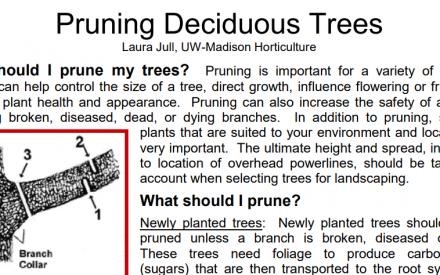
Mary Francis Heimann, O.S.F., Distinguished Outreach Specialist emerita at the University of Wisconsin-Madison and Brian Hudelson, UW-Madison Plant Pathology
Revised: 12/9/2004
Item number: XHT1026
What is bacterial canker? Bacterial canker is a common and sometimes lethal disease of trees in the genus Prunus including cherry, plum and peach. Bacterial canker is also known as “gummosis”, “blossom blast”, “dieback”, “spur blight” and “twig blight”.
What does bacterial canker look like? Often branch dieback is the first symptom of bacterial canker that homeowners notice. However, other more subtle symptoms of flowers, leaves, fruits and branches typically precede this dieback. Initially, infected trees are symptomless. Infected flowers often open, but then collapse. Infected leaves become spotted and yellowed. The centers of leaf spots often shothole (i.e., fall out). If spotting is severe, leaves may fall off. Infected fruits develop dead spots surrounded by water-soaked tissue. Spots can eventually develop into a fruit rot. Branch or trunk infections often occur at pruning sites and lead to cankers (i.e., sunken, dead areas). Cankers often produce a gummy, resinous ooze, and wood in the cankered area is typically discolored. Flower, fruit and branch infections can become systemic, leading to twig dieback, death of larger branches or even death of an entire tree.
Where does bacterial canker come from? Bacterial canker is caused by the bacteria Pseudomonas syringae pv. syringae (Pss) and P. syringae pv. mors-prunorum (Psm). These bacteria overwinter in cankers, in asymptomatic, systemically infected branches, and in buds of susceptible trees. Pss is also known to occur naturally on the leaves of many plants including many weed species. Both Pss and Psm can subsequently be spread by rain splash, wind or insects. The bacteria can also be spread to healthy branches when contaminated pruning tools are used. Infections most often occur during cool, wet conditions.
How do I save a plant with bacterial canker? Prune infected branches at least 12 inches below cankers or other dead tissue, and dispose of branches by burning or burying them. Disinfect pruning tools after each cut by dipping them for at least 30 seconds in a 10% bleach solution or alcohol (spray disinfectants that contain at least 70% alcohol can also be used). Prune branches only during the winter (e.g., Jan. and Feb.) or during dry periods in late summer (e.g., Aug.). DO NOT prune during the cool, wet periods (e.g., spring and fall).
How do I avoid problems with bacterial canker in the future? Healthy trees are better able to slow the development of bacterial canker. Therefore make sure that trees are watered and fertilized properly. Keep weeds and other plants that may harbor bacterial canker pathogens from around the base of susceptible trees. Copper-containing sprays have been advocated for bacterial canker management. However, in many areas, copper-resistant strains of Pss and Psm are present and therefore copper sprays are ineffective.
For more information on bacterial canker: Contact your county Extension agent.
Download Article





 Armillaria Root Disease
Armillaria Root Disease Black Knot
Black Knot Verticillium Wilt of Trees and Shrubs
Verticillium Wilt of Trees and Shrubs Pruning Deciduous Trees
Pruning Deciduous Trees


